
The southern platyfish, common platy, or moonfish is a species of freshwater fish in family Poeciliidae of order Cyprinodontiformes. A live-bearer, it is closely related to the green swordtail and can interbreed with it. It is native to an area of North and Central America stretching from Veracruz, Mexico, to northern Belize.
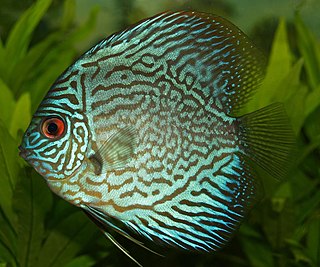
Symphysodon, colloquially known as discus, is a genus of cichlids native to the Amazon river basin in South America. Due to their distinctive shape, behavior, and bright colors and patterns, discus are popular as freshwater aquarium fish, and their aquaculture in several countries in Asia is a major industry. They are sometimes referred to as pompadour fish.

The Rio Negro, or Guainía as it is known in its upper part, is the largest left tributary of the Amazon River, the largest blackwater river in the world, and one of the world's ten largest rivers by average discharge.
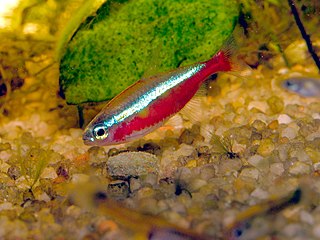
The cardinal tetra is a freshwater fish of the family Characidaeof order Characiformes. It is native to the upper Orinoco and Negro Rivers in South America. Growing to about 3 cm (1.2 in) total length, the cardinal tetra has the striking iridescent blue line characteristic of the genus Paracheirodon laterally bisecting the fish, with the body below this line being vivid red in color, hence the name "cardinal tetra". The cardinal tetra's appearance is similar to that of the closely related neon tetra, with which it is often confused; the neon's red coloration extends only about halfway to the nose, and the neon's blue stripe is a less vibrant blue.

The zebra oto or tiger oto is a fish of the genus Otocinclus of the family Loricariidae that originates from Peru.

The green terror is a colorful freshwater fish in the cichlid family. The fish originates from the Pacific side of South America from the Tumbes River in Peru to the Esmeraldas River in Ecuador. It is polymorphic and can have white or gold-orange edging to the tail and dorsal fins. It has historically been confused with two other species that always have narrow, clearly defined white edging, the more southerly distributed A. stalsbergi and the more northerly A. blombergi.

Heros is a genus of cichlids native to the Amazon, Orinoco and Essequibo River basins in South America. They were previously included in the genus Cichlasoma before its restriction to the distinct group of "Port Cichlids."

The rummy-nose tetra is a species of tropical freshwater characin fish originating in South America, popular among fishkeepers as an aquarium fish. One of many small tetras belonging to the same genus, it is on average 5 cm (2 in) long when fully grown, and is a long established favourite among tropical fishkeepers. The fish is one of several very similar species including Hemigrammus bleheri, and Petitella georgiae, and it is possible that more recently collected specimens available in the aquarium trade are members of one or other of these similar species. The common name applied to most of these fishes is "rummy-nose tetra", though other common names are in circulation.

Mikrogeophagus altispinosus is a species of fish endemic to the Amazon River basin in Brazil and Bolivia. The species is part of the family Cichlidae and subfamily Geophaginae. It is a popular aquarium fish, traded under the common names Bolivian butterfly, Bolivian ram, Bolivian ram cichlid, and ruby crown cichlid.
Heros severus, is a species of tropical freshwater cichlid native to the upper Orinoco and upper Rio Negro basins in South America. It has historically been confused with several other species in the genus, most recently H. liberifer.

Hoplarchus is a genus of cichlid in the tribe Heroini. It contains the single species Hoplarchus psittacus, which is endemic to the blackwater rivers in Brazil, Colombia and Venezuela, including the Rio Negro, Jamari, Preto da Eva, Urubu rivers and upper Orinoco drainages. This fish can reach a length of 35 centimetres (14 in) TL and is important as a food fish to local indigenous peoples. This species is occasionally kept as an aquarium fish and is traded under the common name "parrot cichlid".
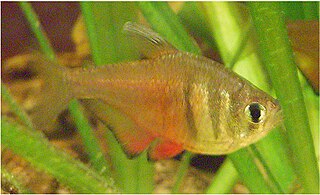
The flame tetra, also known as the red tetra or Rio tetra, is a small freshwater fish of the characin family Characidae. This tetra was first introduced as aquarium fish in 1920 by C. Bruening, Hamburg, Germany, and formally described in 1924 by Dr. George S. Myers. Today large numbers are bred in captivity and it is common in the aquarium trade, but the remaining wild population in Southeast Brazil is highly threatened.

Pseudacanthicus is a genus of medium to large-sized suckermouth armored catfishes native to South America, where found in the Amazon and Orinoco basins, as well as rivers of the Guianas. They are primarily found in fast-flowing waters, sometimes relatively deep. They are sometimes kept in aquariums.

An aquarium is a vivarium of any size having at least one transparent side in which aquatic plants or animals are kept and displayed. Fishkeepers use aquaria to keep fish, invertebrates, amphibians, aquatic reptiles, such as turtles, and aquatic plants. The term "aquarium", coined by English naturalist Philip Henry Gosse, combines the Latin root aqua, meaning water, with the suffix -arium, meaning "a place for relating to".

Heros efasciatus is a species of tropical freshwater cichlid native to the Amazon basin in South America. It is commonly found in the aquarium trade, often in its gold colored variation rather than the wild-type olive green one.

Baryancistrus xanthellus is a species of armored catfish endemic to Brazil. It is a benthic fresh water fish that lives in Rio Xingu in the Amazon system. It reaches a length of 22.4 centimetres (8.8 in) SL. There are larger species that occasionally enter the hobby as well.
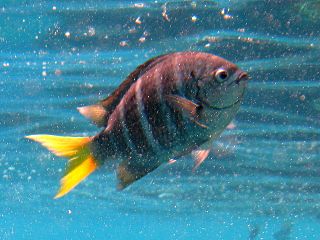
The yellowtail sergeant is a species of damselfish in the family Pomacentridae. They are found in the Indo-Pacific. It can grow up to a maximum length of 17 centimetres (6.7 in).

Project Piaba is a fishery initiative located on the Rio Negro tributary of the Amazon River. The program both promotes and researches sustainable aquarium pet fish collection and its impact on the environment. The name of the project comes from the Brazilian Portuguese word, piaba, which means "little fish", referring specifically to the cardinal tetra. Project Piaba is an ongoing project with annual research expeditions to the Rio Negro region. Because of the sustainable nature of the project, its slogan is "Buy a Fish, Save a Tree!"
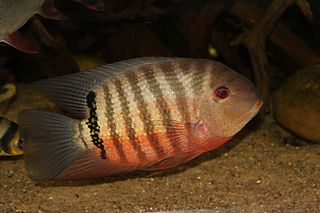
Heros liberifer is a species of tropical cichlid native to lentic habitats, especially flooded forests, in the upper and middle Orinoco basin in South America.

















